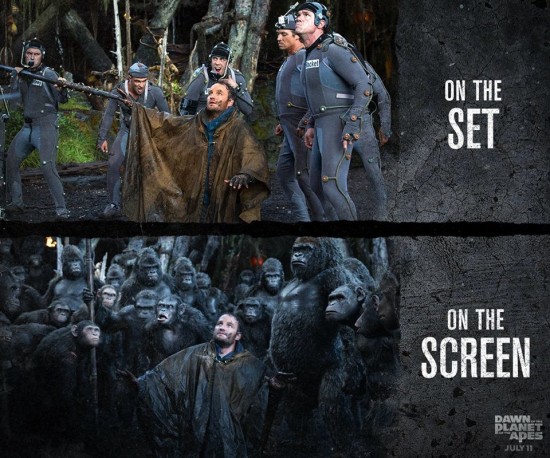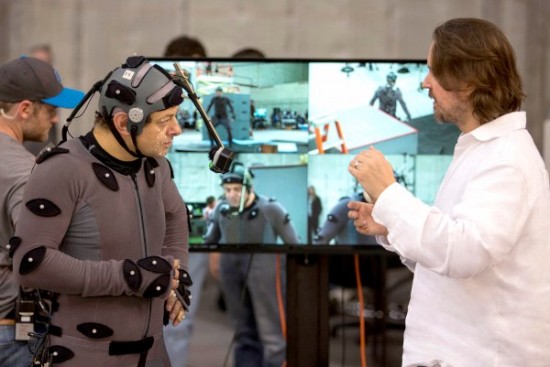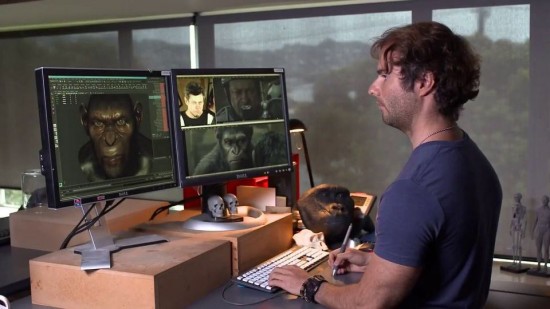One FX Shot In 'Dawn Of The Planet Of The Apes' Took 1030 Iterations
One of my favorite shots in Dawn of the Planet of the Apes involves an ape taking control of a tank and running amuck in post apocalyptic San Francisco. Its great because of the way its presented — the sequence appears to be a single shot mounted from the back of the tank turret. During my conversation with director Matt Reeves, he talked a bit about the frustrating long process of waiting over a year to finally see the final vision realized through completely rendered visual effects. My favorite shot turns out was the most difficult shot to complete, taking a whopping 1030 iterations from the vfx wizards at WETA before Reeves signed off. Read about what went into a single "shot" of Dawn of the Planet of the Apes, after the jump.
Before we talk about the post production process, lets talk about the visual effects process of production. Dawn of the Planet of the Apes was the first movie to record most of the performance capture on their many live-action locations. Recording on location is much harder than recording performance capture on a stage, and Dawn was the first film to do this in bulk. But after principal photography ends, they begin recording more nuanced performances in a small performance capture studio which is called "The Volume." They shoot a lot of plate shots on location so they can either insert the apes in later or sometimes recreate backdrops in the computer.
For like the battle scene for example, like the big battle scene, most of that was done in the Volume. We got the plates for it and actually my VFX Supervisor from Let Me In was the Second Unit Director, a good friend of mine, Brad Parker. And I was so fortunate that he came in, because the schedule was such and it was so hard the shoot that I needed somebody to get those plates for me. And he did, and he staged a bunch of shots, but a lot of shots were totally restaged in the Volume. And then some of the shots were the same staging, but I changed the performances. Like what's crazy is that you can go back in to any shot that's been done and you can get a new performance, a new moment, a new line, not just a new line, but a new everything that fits within that plate. So at a certain point there were some plates that are very much like the action that it was designed for. And then other plates where I was like going, let's just take every plate we have, when we were editing it, I said, let's take every plate we have and let's just think about the story that we need to tell. And we took plates that were not or things that weren't even plates that were like the ends of things or like there's a part, there are parts of shots that were never intended to be used. And we found the way to tell that story yet again so we could continue writing in post.
So in post production, they would go to James Cameron's company Lightstorm at Manhattan Beach Studios and record data for additional performance capture.
It's basically a big fluorescent lit room like a stage with no set in it. And we would then populate those shots. And I'd have those shots and I'd say, okay, so here's the shot here and what I'm thinking is as that's happening, this is a moment on Blue Eyes and he's ducking and hiding over here. And it was like we were doing, we could constantly not just remake, but re, we could all constantly refine and add and add and add and add.
Now for instance, the tank turret shot that I loved was something they planned very early on, but it took the entire length of pre, production and post to complete. Matt explains the origin of the shot:
I want the movie to have a lot of point, you know, point of view is the most important thing to me. And, you know, I felt that way in Cloverfield and that way in Let Me In. And it was totally that way this way. I wanted you to have the shifting points of view. And when we came up with that shot, the idea, the easy part was actually shooting the shot. 'Cause the, 'cause all you had to do was, which was not no easy task, but you basically, we had a tank. It was on a turret. We mounted the camera on there and Brad shot this for me. And it basically runs the set. And there's nothing on the set in terms of actors, it's just the plate. And then it crashes into the wall. And it was supposed to knock down the column and break open those doors. It was all rigged to do that. And the stuff happened in a way where it didn't work. And so Weta actually had to take over that one part of the shot. But other than that, that plate is exactly the plate that you see in the movie. But there was nothing in it.
So then the shot gets sent to WETA where the visual effects artists spent the next year crafting the magic.
We spent then the next year creating that shot. It was one of the last shots that we we finaled. Though we turned it over very early. And basically what happened was we returned to the Volume multiple times to continue to refine the action in it. And what Toby did on the tank turret and what the different zones were. And we continued to refine it so that it would take in the scope of this, you know, almost like a fever dream, would take in the scope of this battle. And then end with this reveal, oh my God, they've been heading inexorably this whole time right toward the doors and this is how the battle's gonna end. And you would see all of that in this way that looks like we shot it in one shot.
But it isn't one shot, its plates shot on set, mixed with many performances captured in the volume, and then over 1000 iterations of visual effects work.
Making of Dawn of the Planet of the Apes by CGMeetup
Here's what's funny. So you get these shots in and they name each version a number, right?
So you get your blocking version maybe like version 20. It means they've tried 20 versions of blocking and then they feel like here's one they wanna present to you. So you look at 20 and you go, oh not quite. And then maybe they do another five. Then you do animation passes. And so after you've approved the blocking, then they started working in animation. And then that may be like another hundred passes. I might say like you know in Andy's eyes, he looks not just sad the way you have here, but he also looks angry. Can we look at Andy? And we look at Andy and we say, oh yeah, there's a different shape in his eye. Can you make sure that you get that shape? And we do all that kind of stuff. So that ends up being, you know, a shot can go through the final version number. Then there's hair simulation, then there's lighting and rendering, all that. The final version number may be, you know, as many as like a couple hundred. So you might be like, you know, here's version 200 of this thing. Just for one shot. That shot, the final version I believe the version number was 1030.
That means that WETA went through 1030 iterations of that shot before Matt Reeves finally said "I think we got it, guys."
I finaled it like two and a half weeks ago [3 weeks before the film's premiere]. I mean, it was like one of the last shots that we finaled. And we had like a six hour phone call with Weta every day and we'd be on the phone. They were all in New Zealand at a different time. We're like on the phone looking at shots, talking and I'm saying, okay, so that one's approved, that one's not approved. That shot, when we said, okay, that's it, there literally was applause and like screaming that erupted on the other side because that shot was essentially worked on for about a year. And they're, you know, there's 800 or a thousand animators at Weta. I don't even know how many artists worked on that shot. But it took 1030 versions to get it right.
And as an audience member, I applauded in a small screening room after seeing this sequence. I can't speak for Matt, but for me, it was all worth it.



